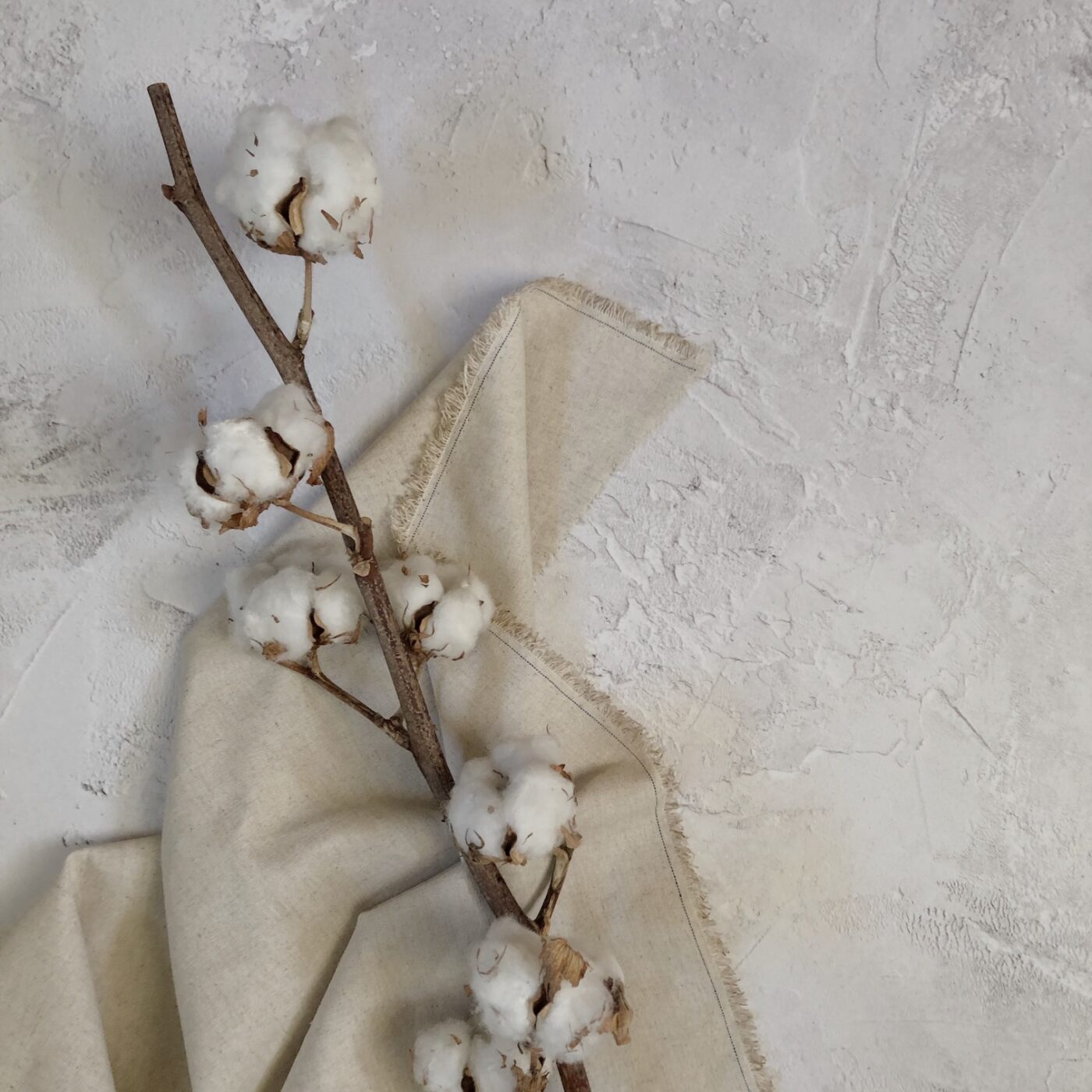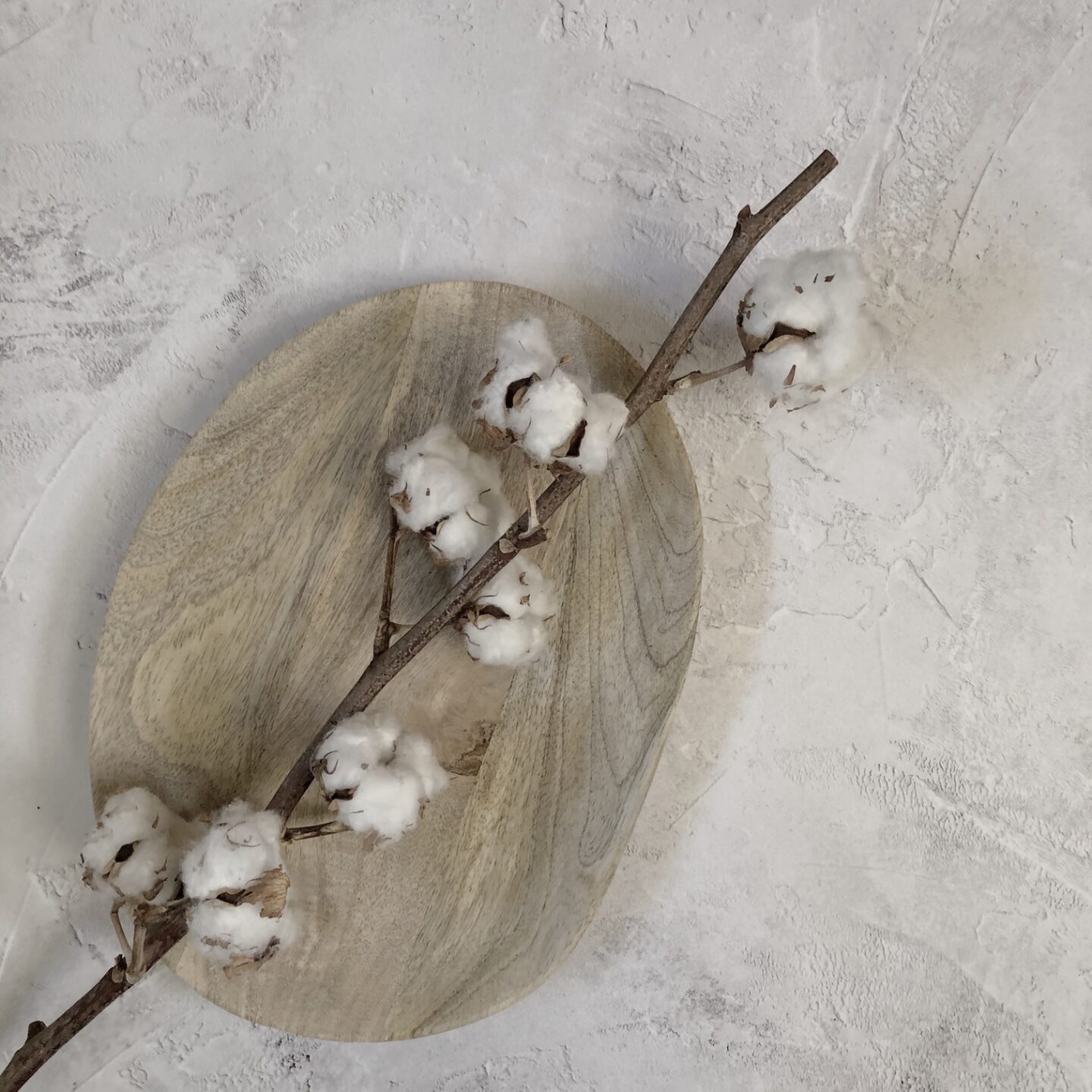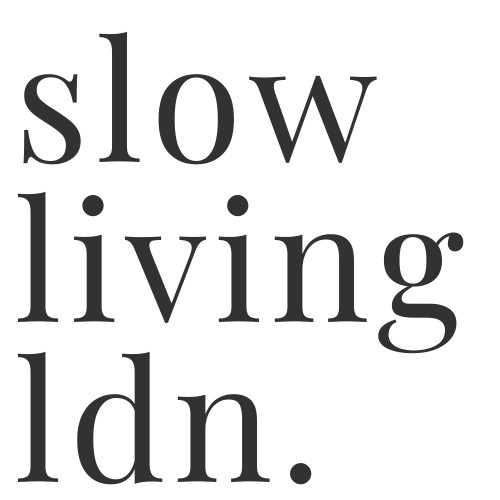You have no items in your cart. Want to get some nice things?
Go shopping
How sustainable are the clothes you wear and the textiles you fill your home with?
The social and environmental impact of fast fashion and the textile industry is multi-faceted. It takes huge amounts of water to produce certain types of textiles. Local communities are at risk of chemical run-off and soil degradation. And the industry is high in carbon emissions pollution – just to name a few issues.
As consumers, we’re becoming more aware of the journey our clothing has taken to reach us. Established brands are responding by including organic and alternative fabrics as part of their collections, but you still might not be clear on how fabrics truly compare.
Before considering which fabric to choose, the first step towards adopting a slow fashion and slow interiors mindset is to buy less, but buy better quality. Buy what you love and what you will continue to love, regardless of seasons and trends.
When it comes to choosing the most sustainable fabrics, we’ll explain the best options as well as the negative impacts of synthetics and some natural textiles. Plus, we’ll share the labels to seek out for traceable fabrics.
The Least Sustainable Fabrics
Synthetics
Polyester, nylon and acrylic are all plastic-based fabrics. Polyester is made from polyethylene terephthalate (PET) and is therefore in part derived from petroleum. These synthetic fabrics are mostly non-biodegradable and resource intensive to produce, while they also make use of harmful dyes.
While plastic-based textiles can be quite durable and highly suitable for stretchy sports gear, every time a garment is washed it also releases microfibres or tiny bits of plastic. These are invisible to the naked eye but can be ingested by marine life and, in turn, us. Friends of the Earth explain that these tiny microfibres can absorb high levels of toxins from detergents that later enter the food chain.
According to the IUCN report ‘Primary microfibres in the oceans’, the quantity of primary microfibres entering the ocean each week is the equivalent of every person on the planet dropping a plastic bag directly into the sea.
A Note on ECONYL
Some brands are using innovative new fabrics made from recycled plastic. ECONYL is one example which is made from reclaimed fishing nets and plastic debris. The result is a new nylon yarn that is said to be equal in quality to virgin nylon. While reducing the production of new synthetics and plastic waste is positive, recycled plastic-based fabrics will still shed microfibres when washed. It is best to consider ECONYL for footwear and items which are not regularly washed.
Cotton
While cotton is a natural fibre that biodegrades, it is water-intensive to grow and crops are at high risk of infestation. To create a single kilogram of cotton – approximately the same as one pair of jeans and a man’s shirt – it takes between 10,000 and 20,000 litres of water (GLASA, quoted in WRAP’s Valuing our Clothes report).
The high use of pesticides in the production of cotton degrades the soil and puts farmers’ yields further at risk, while the dangerous run-off is also harmful to their health. In China, it’s estimated that 70% of rivers and lakes are contaminated by the 2.5 million gallons of waste water that’s created by the fashion industry.
The cotton industry is also highly complex and often leaves small scale farmers struggling to make ends meet. Farmers are reliant on middle men (ginners who process the cotton) to buy their crops while they face rising costs of production, fluctuating market prices and decreasing yields. Subsidies given to farmers in the US and the EU also artificially lower the global prices for cotton.
Fairtrade.org depicts a desperate situation for growers in India, “many farmers are seriously indebted because of the high-interest loans needed to purchase fertilisers and other farm inputs and have, in desperation, resorted to ending their lives.” Some debate whether the use of expensive genetically modified seeds to fight bollworms (a common pest when growing cotton), has also contributed to high suicide rates in Indian farmers. Farmers gamble on achieving their desired yields, yet, many don’t have a true understanding of GM technology and that their crops can still be susceptible to other pests. Reports of counterfeit seeds flooding the market has also put yields at risk, with farmers believing they don’t need to use pesticides.
Read more on the Bt cotton debate in India.
What About Bamboo Fabric?
Bamboo products have been popping up across many sectors, including homeware and fashion. Bamboo fabric is often heralded as a sustainable alternative, but in reality, the processing can be far from eco-friendly.
Bamboo regenerates from its own roots and can grow extremely fast without pesticides and much water. So far, so good. However, bamboo is usually grown in mono plantations (and land is often cleared to make way for it), reducing biodiversity. According to The Green Hub, the majority of bamboo fabric is viscose or regenerated cellulose fibre (rayon). Rayon is semi-synthetic because it contains natural fibres but these are broken down by harsh chemicals. Those used to dissolve the bamboo stalk include sodium hydroxide and toxic carbon disulfide.
In 2017, the Changing Markets Foundation released their Dirty Fashion report which shed light on the polluting practises of viscose manufacturers in Indonesia, China and India. The report highlighted the dumping of wastewater that has lead to the contamination of local waterways, affecting traditional livelihoods such as fishing. Regular exposure to high levels of carbon disulfide has been linked to cancer, birth defects and skin conditions for those living near factories.
The Most Sustainable Fabrics: Organic and Other Alternatives

Organic and Recycled Cotton
Organic cotton helps protect farmers and local ecosystems by using natural processes instead of toxic chemicals. According to the Soil Association, healthy soil retains water for longer and soaks up carbon. Organic cotton therefore creates 46% fewer emissions than non-organic. Rather than relying on GM seed suppliers, organic cotton farmers can also continue to use their own seeds year after year.
Good On You considers recycled cotton to be one of the most sustainable fabrics around with the potential to reduce energy and water use, while also reducing textile waste ending up in landfill.
Linen
When choosing clothing and household items, such as bedding and tableware, linen, made from flax, is one of the most sustainable choices. When not treated (not dyed), linen is fully biodegradable. According to Good On You, every part of the flax plant is traditionally used to make linen, while linseed oil is a useful by-product. Flax uses much less water than cotton and can grow in poor soils. Despite these positives, it’s often regarded as a luxury fabric and sold at high prices due to the manual processes needed to make linen yarn.
Go for unbleached, natural hued linens and opt for organic linen where possible.
Hemp
The bast fibre (long strands of soft, woody fibre from the stem) of hemp plants creates strong and durable fabric. Hemp is a fast-growing weed which requires little water and chemicals to grow in abundance in a relatively small space. It also returns nutrients to the soil.
Once separated from the bark, fibres are spun together to form a continuous thread that can be woven into fabric. This process can be done organically without chemicals, however, Good On You advises that some manufacturers do use chemicals to produce it more quickly. Chemicals may also be present if the fabric is dyed or if fertilisers are used when growing. It’s therefore important to look for organic hemp where possible.
Lyocell
Lyocell is made from tree pulp and is being included in collections by major high street retailers. It’s mostly made from eucalyptus which grows quickly without the need for irrigation or many pesticides. Eucalyptus can also grow on land that is not suitable for growing food. The pulp from the wood is dissolved by amine oxide to leave raw cellulose which is spun to create fibres. You may have also heard of Tencel which is a branded name of lyocell fabric.
It’s a soft fabric that can also be found blended with other textiles. The non-toxic amine oxide and water needed can mostly be re-used (unlike when producing viscose), which is another benefit of lyocell. It’s also biodegradable.
However, lyocell production, though more sustainable than synthetic options, is not without its drawbacks. These include the risks of mismanagement of eucalyptus tree plantations (Tencel claims to use sustainable sources) and the chemicals used during the dying process. Lyocell doesn’t take dye well and also ‘pills’ (when the surface of fibres begins to peel away) meaning that harsh chemical use can be high.
Sustainable Clothing Labels
GOTS – Global Organic Textile Standard
GOTS is the worldwide standard for organic textiles which covers the entire production process from harvest to manufacture and also sets out social criteria to ensure safe and fair working conditions. Some key points of GOTS certified textiles include:
- Products with the GOTS label ‘organic’ must have at least 95% certified organic fibres
- The label ‘made with organic’ must have at least 70% organic fibres
- All chemical inputs such as dyes and process chemicals must be evaluated to conform to basic requirements on toxicity and biodegradability
- Accessories can’t contain PVC, nickel or chrome
- Operators must have an environmental policy with goals to minimise waste
- Waste water must be processed in a waste water treatment plant
- Packaging material can’t contain PVC and all materials such as tags must be recycled or certified according to FSC (Forest Stewardship Council) or PEFC (Programme for the Endorsement of Forest Certification)
- Adherence to safe working conditions, living wages, regular employment and non-excessive working hours
Read more on GOTS.
GRS – Global Recycled Standard
GRS is a hollistic certification that also requires adhering to environmental criteria, including water and waste management and chemical use, and to social criteria for the welfare and fair treatment of workers. This label means there is at least 50% GRS certified material used.
There are also labels for RCS (Recycled Claim Standard) which are used to track raw materials through the supply chain. RCS 100 means at least 95% of the product comes from recycled materials and RCS Blended means between 5% and 95% recycled content.
With this information, we hope that you’ll feel more confident about the different pros and cons of each fabric’s growing and manufacturing processes in terms of sustainability. When buying textiles, check the labels and opt for organic or lower impact fabrics where possible. Also, look out for the certifications above, such as GOTS and GRS, to buy with confidence both socially and environmentally.
More inspiration:
- Choosing new bedding? Read our guide to sustainable bed linen.
- Learn about the Japanese wabi-sabi philosophy.
- Brush up on the theory behind colour psychology.
- Read our five steps for planning a considered interiors project.
- Browse some of our favourite independent magazines for slow living.
